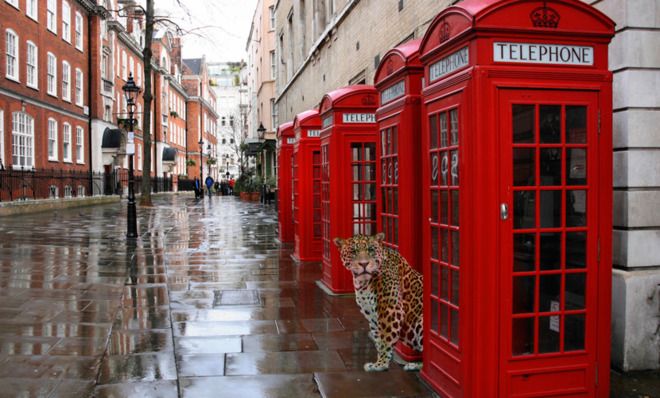The mystery of Britain's alien big cats
Each one is named like a duke: The Beast of Bodmin. The Beast of Burford. The Wildcat of Woodchester.


In 1983, a farmer in South Molton, a small town in the southern English county of Devon, reported a startling loss in livestock: 100 sheep had been killed, apparently violently, over a period of three months. Their throats had been slashed across. For many, the slaughter confirmed the area's vague but persistent legend, sighted since the early 1970s, of a large, possibly phantom cat. Named for the hilly moorland it was said to roam, they called it the "Beast of Exmoor."
The public reacted swiftly. The Daily Express offered the equivalent of a $1,600 reward for video footage of the Beast. More surprisingly, the British government sent a group of Royal Marines snipers into the hills to find (and possibly kill) the creature. The seriousness with which they treated the mission can probably be assessed through the name they gave it: "Operation Beastie." Still, the snipers looked for three nights, until the Ministry of Defense called off the search due to concerns they might mistakenly shoot one of several reward-seeking amateur photographers thought to be on the same hunt.
It's unclear exactly how many people actually saw the Beast — by some accounts, a few of the Marines did see something, though after the search's end the Express stated that the only witness was a 16-year-old girl being driven to work. "At first I thought it was a cat but it was too big for that," she said. "It was black and had a long tail. There was white on each foot."
Subscribe to The Week
Escape your echo chamber. Get the facts behind the news, plus analysis from multiple perspectives.

Sign up for The Week's Free Newsletters
From our morning news briefing to a weekly Good News Newsletter, get the best of The Week delivered directly to your inbox.
From our morning news briefing to a weekly Good News Newsletter, get the best of The Week delivered directly to your inbox.
The trouble with a monster that's said to look mostly just like a normal house pet, but a little bigger, is that it can be hard to know the difference. Superintendent Douglas McClary, also quoted in the Express, conceded (rather troublingly, I think), "Until we shoot the damned thing, we don't know what it is."
According to the BBC, Great Britain's largest and deadliest carnivore is a badger. And yet, there is a legendary feline monster for every moor and field, each one named like a duke: The Beast of Bodmin. The Beast of Burford. The Wildcat of Woodchester. Phantom cats have been spotted worldwide, but they're a particularly British phenomena. They're variably called British Big Cats, or mystery cats, or Alien Big Cats. (ABCs, for short.)
There is a citizen group of researchers devoted to their study: the British Big Cat Society. (On the left-side navigation bar: "Big Cat News." "Big Cat Links.") By their most recent report, 2,123 big cat sightings were reported between April 2004 and July 2005.
As it goes with any mystery, the vast majority of these sightings aren't supported by anything more than a story. But there are pictures, and a handful of videos. The British Big Cat Society collects them, but reserves most viewing privileges for its dues-paying members. Its public page does provide, along with a few other photographs, a still from a famous two-minute video taken in 1994 by a man named William Rooker. It's blurry and small, but it does seem to show a fairly big black cat roaming a field. This one's name is the Fen Tiger, of Cambridgeshire.
Sign up for Today's Best Articles in your inbox
A free daily email with the biggest news stories of the day – and the best features from TheWeek.com
Another video, taken in 2009, coincided with an alleged sheep-killing spree in the area. It, too, is blurry, but there's definitely something black and cat-like at the far edges of the screen.
It's important to note that, despite everything the name "phantom cat" conjures up, British Big Cats are not widely considered to be paranormal in nature. In contrast to their canine cousins — the ominous black ghost dogs with glowing red eyes, described in local legend for years before inspiring Sir Arthur Conan Doyle's The Hound of the Baskervilles — the big cats spotted around Great Britain are (for the most part) thought to be real, three-dimensional creatures. They're from Earth, not hell. It's just that they don't belong in Great Britain.
The Dangerous Wild Animals Actwas enacted by the British government in 1976 in response to the purchase of exotic animals as pets, a then-growing trend in the United Kingdom. The law states: "No person shall keep any dangerous wild animal except under the authority of a licence granted in accordance with the provisions of this Act by a local authority."
In response, in order to avoid prosecution, many private collectors are thought to have let their pets — Bengal cats, pumas, wolfhounds, etc. — loose. And in the years since, there have been a handful of big cats (otherwise anomalous to the region) captured or killed on the British Isles. Because many big cats (including cougars and pumas) don't live more than 12 to 15 years, this hypothesis lost strength after, say, 1991. But some suspect that those pets that survived in the wild may have bred with domestic animals or other native species, and that these may account for the repeated sightings of ABCs.
According to the news at the time, authorities who'd studied paw prints supposedly left by the Beast of Exmoor believed it to be a panther. The Dangerous Wild Animals Act had passed just seven years earlier, so maybe it was. But then, of course, there are the 1995 reports, and the 2001 reports. In 2009, a number of residents of North Devon (along with the Daily Mail) wondered if a body that washed up on shore could be the famous Beast. About five feet long, with black fur and sharp teeth, it seemed to fit the profile. Only, tissue samples revealed it to be a grey seal.
As for continued sightings (which seem unlikely to cease), Discovery offers a plausible, slightly insulting explanation for humans' repeated insistence that the animals they're seeing are not, could not possibly be, just cats: "People are simply not very good at estimating the size of objects, especially when they are excited or alarmed." If ever there were a reason to put a life-sized, cardboard cutout of an average-sized house cat in one's backyard (or backmoor, as the case may be), this is it.
Pacific Standard grapples with the nation's biggest issues by illuminating why we do what we do. For more on the science of society, sign up for its weekly email update or subscribe to its bimonthly print magazine.
More from Pacific Standard...
-
 Today's political cartoons - January 19, 2025
Today's political cartoons - January 19, 2025Cartoons Sunday's cartoons - moving to Canada, billionaire bootlickers, and more
By The Week US Published
-
 5 inflammatory cartoons on the L.A. wildfires
5 inflammatory cartoons on the L.A. wildfiresCartoons Artists take on climate change denial, the blame game, and more
By The Week US Published
-
 The problems with the current social care system
The problems with the current social care systemThe Explainer The question of how to pay for adult social care is perhaps the greatest unresolved policy issue of our time
By The Week UK Published